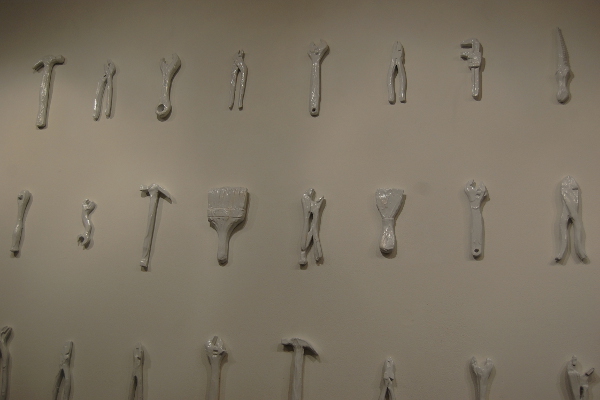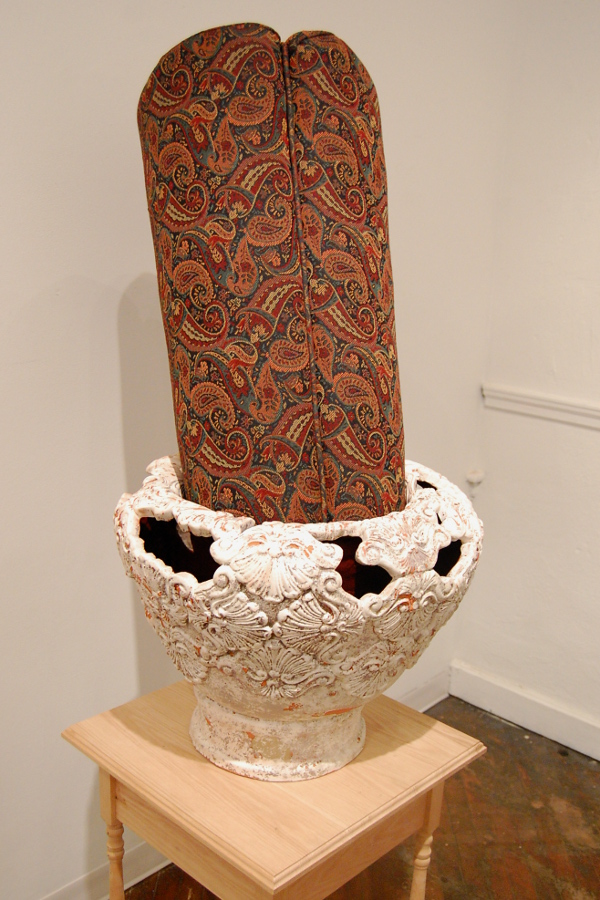
Patrick Coughlin’s tools teach us more than how to use them at Napoleon
Despite being among humanity’s greatest assets – ones that streamline our workloads and increase our creative potential – tools don’t always get the respect they deserve. Often taken for granted as means to an end, the instruments we use to accomplish ordinary tasks have been utilized and perfected since prehistory. Patrick Coughlin has taken it upon himself to see the humble hammers of the world held aloft as art objects in their own right for his solo exhibition, “Tools of the Trade,” currently on display at Napoleon.
The longest expanse of wall space in the gallery is dedicated to a veritable who’s who of tool types, showcasing wrenches, paintbrushes, pliers and their kin. Most of the objects in this show are at least partly constructed from clay, but this spread is noteworthy due to the evenly dispersed layout and the fact that every apparatus is glazed in glossy white. By reducing these implements to forms by way of a monochromatic exterior, we may focus on their manifold varieties and designs, and obtain some context for the larger, more elaborate pieces presented here.
Patrick Coughlin, “Hammer.”
In response to the tiny claw hammers across the way, Coughlin’s hulking, Thor-worthy “Hammer” rests firmly on the opposite side of the room next to an equally gigantic pipe wrench. Unlike the minimal composition of the tinier tools, this earthenware hammer contains a thick, sledge-like head and a significant amount of detailing on its elaborate handle. The grip is a hollow lattice of curling rococo leaves, providing a sharp visual split between the heavy, functional top and the ornate lower half, and offering insight into the power of decoration to affect value and meaning.
Patrick Coughlin, “The Mortar and Pestle.”
As if the division between the holding areas and the working areas were not apparent enough, the artist upholsters a number of his larger-than-life recreations, such as “The Mortar and Pestle.” The bowl of the mortar looks a bit like carved ivory, while the pestle is made from a rounded cut of paisley fabric. As if it were the crushing apparatus from some mystical ceremony, this carefully adorned pair could easily be mistaken for a wholly abstract sculpture if not for their accompanying sculptures.
By embellishing these would-be tools, Coughlin reminds us that although these manifestations represent functional devices, a human hand must at some point fabricate even the things we use in the process of creation. This production and reproduction bears quite a bit of likeness to the human condition at large, whether in regards to engineering, procreation, or even agriculture; these artworks are, after all, built from clay, which is not a far cry from the soil which yields our crops.
If anything can be said about Patrick Coughlin’s body of work aside from its fine craftsmanship, it is the sheer breadth of interrelated concepts. Although it may be hard to believe that an exhibit of wrenches, irons, and other simple machines could provide commentary on the power of ornamentation, creative vision, and evolution of both a species and its technology, “Tools of the Trade” manages to forge these and more into one elegant package. The show will be on view through February 27.
Napoleon is located at 319 N. 11th St., on the second floor, Philadelphia; [email protected]; napoleonnapoleon.com.
Recent Content
-
Artsarticle ·
-
Artsarticle ·
-
Artsarticle ·


